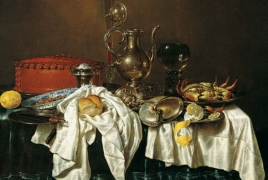17th century works from Netherlands, China on view at Frans Hals Museum March 25, 2017 - 16:20 AMT PanARMENIAN.Net - Barbarians & Philosophers sheds light on the way China and the Netherlands formed images of one another in the seventeenth century. The Dutch were fascinated by the culture of the ‘Celestial Empire’; the Chinese were astonished by the Dutch ‘redheaded barbarians’. A selection of paintings, drawings, porcelain and models charts the cultural exchange. The exhibition in the Frans Hals Museum runs from 25 March to 20 August 2017, Art Daily said. In the seventeenth century, the Netherlands was a key player in a worldwide network of trade relationships. This was reflected in what was sold, made, shown and experienced in the Dutch Republic. The Frans Hals Museum | De Hallen Haarlem invites you to take a comprehensive look at the Golden Age in Barbarians & Philosophers, which focuses on the first contacts between the Netherlands and China. In the sixteenth and seventeenth centuries, the Netherlands was one of the few European countries to have contacts with the Chinese Empire – the Middle Kingdom. Nowadays many Europeans regard China with admiration and sometimes with surprise at the economic boom the country is undergoing. Products ‘Made in China’ are inescapable parts of our daily lives, but the image of the country is less clear. The Chinese language, traditions, philosophy and the age of Chinese civilization are not always easy to fit into the Western world view. This situation is like that in the seventeenth century, when Chinese products became an everyday part of Dutch households and lavishly illustrated books about China proved extraordinarily popular. At the same time, new knowledge often clashed with the old assumptions about the Middle Kingdom. Barbarians & Philosophers sheds light on the reciprocal formation of images that came about through the first close contacts between the Dutch and the Chinese. The Dutch were fascinated by the ‘exotic’ Chinese and their centuries-old culture and knowledge, although by no means everything was equally easily accepted. After their first meeting the Chinese, too, formed an image of the Dutch, as ‘redheaded barbarians’. It is clear that the stereotypes about Chinese customs and practices determined the modern image of China. The exhibition and the accompanying book Barbarians & Philosophers provide an explanation of this multifaceted cultural exchange. Evelyn Taocheng Wang (Chengdu, China, 1981), winner of the 2016 Volkskrant Decorative Art Prize, provides a modern accent in the exhibition. Her one-woman show runs concurrently in De Hallen Haarlem. The exhibition has been put together by Thijs Weststeijn and Menno Jonker. Weststeijn is a Professor of Pre-1850 Art History at the University of Utrecht. He heads the NWO research project ‘The Chinese Impact’. Menno Jonker is an independent curator and researcher in early-modern art and science. He carried out research for the Rijksmuseum’s ‘Asia in Amsterdam’ exhibition. Vantilt is publishing a book with contributions by Leonard Blussé, Jan van Campen, Trude Dijkstra, Lennert Gesterkamp, Noël Golvers, Menno Jonker, Willemijn van Noord, Nicolas Standaert, Jing Sun, Ching-Ling Wang and Thijs Weststeijn to accompany the exhibition. The creative crew of the Public TV had chosen 13-year-old Malena as a participant of this year's contest. She called on others to also suspend their accounts over the companies’ failure to tackle hate speech. Penderecki was known for his film scores, including for William Friedkin’s “The Exorcist”, Stanley Kubrick’s “The Shining”. The festival made the news public on March 19, saying that “several options are considered in order to preserve its running” Partner news |